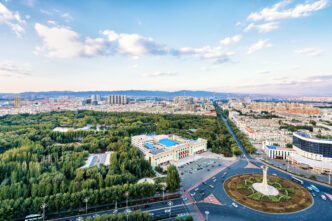A vehicle incident at Toronto Metropolitan University has left four pedestrians injured after a car drove through the pedestrian-only Nelson Mandela Walk. The incident, which occurred on April 15, is being investigated by police as an intentional and targeted attack. Two individuals were hospitalized, one with minor injuries and another with serious but non-life-threatening injuries. The remaining victims sustained less severe injuries. None of the injured were affiliated with the university.
The vehicle involved, a green sedan with a smashed windshield, struck the victims on the cobblestone pathway, which is typically restricted to foot traffic. Authorities suspect the attack was aimed at a specific individual, with other victims being unintended bystanders. The driver fled the scene, and police are exploring the possibility that the suspect and the intended target were acquainted.
The incident unfolded around 2 p.m., sending panic through the campus as pedestrians scrambled for safety. Witnesses described the chaotic scene, with people screaming and running as the car sped away from the area. Noor Almusa, a third-year politics and criminology student, recounted her experience of narrowly avoiding the speeding vehicle after being warned by bystanders. Isaac Meng, an applied math student, witnessed the aftermath and described the fear and confusion among students who witnessed the event.
Toronto Metropolitan University responded with a statement expressing concern for those affected and gratitude towards law enforcement. The university emphasized the availability of support services for those in need and urged any witnesses to assist police with their investigations. As police continue their investigation, they have yet to release a description of the suspect, remaining in the early stages of the inquiry.
The Societal Shift
The recent vehicular attack at Toronto Metropolitan University raises concerns about safety in public spaces, particularly in bustling urban centers. While the incident appears to be isolated, it serves as a reminder of vulnerabilities even in areas typically considered safe. Such events can lead to heightened anxiety among students and staff, potentially affecting the campus atmosphere and sense of security.
In the broader community, there may be calls for increased security measures on pedestrian pathways and university campuses. This could involve the installation of barriers, enhanced surveillance, or greater police presence. While these measures aim to prevent future incidents, they may also impact the openness and accessibility of public spaces, necessitating a delicate balance between safety and freedom of movement.
For the university, ensuring the well-being of its community members becomes a priority. Support services must be readily available to address the psychological impact on students and staff, fostering a supportive environment for recovery and resilience. Additionally, this incident could influence dialogues around campus safety policies, encouraging proactive discussions on preventive strategies and emergency preparedness.






